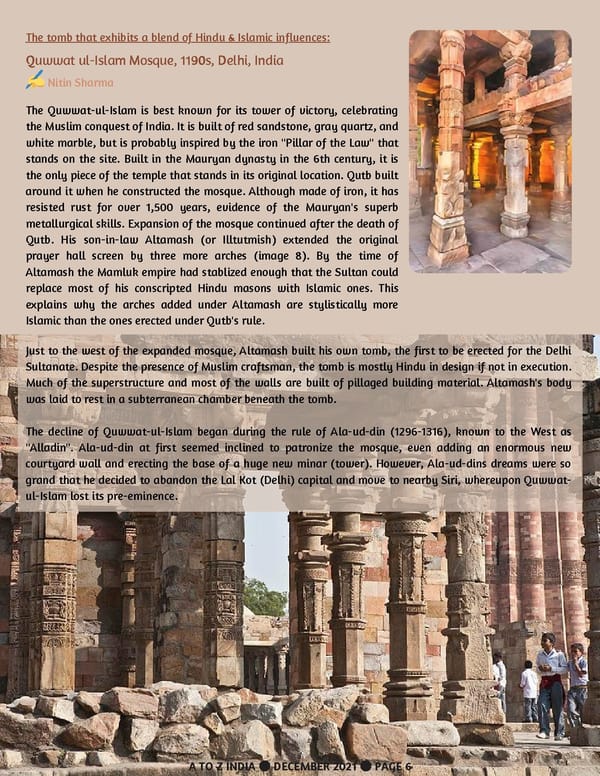Nitin Sharma Quwwat ul-Islam Mosque, 1190s, Delhi, India A TO Z INDIA ● DECEMBER 2021 ● PAGE 6 The tomb that exhibits a blend of Hindu & Islamic influenc es: Just to the west of the expanded mosque, Altamash built his own tomb, the first to be erected for the Delhi Sultanate. Despite the presence of Muslim craftsman, the tomb is mostly Hindu in design if not in execution. Much of the superstructure and most of the walls are built of pillaged building material. Altamash's body was laid to rest in a subterranean chamber beneath the tomb. The decline of Qu wwat-ul-Islam began during the rule of Ala-ud-din (1296-1316), known to the West as "Alladin". Ala-ud-din at first seemed inclined to patronize the mosque, even adding an enormous new courtyard wall and erecting the base of a huge new minar (tower). However, Ala-ud-dins dreams were so grand that he decided to abandon the Lal Kot (Delhi) capital and move to nearby Siri, whereupon Quwwat- ul-Islam lost i ts pre-eminence. The Quwwat-ul-Islam is best known for its tower of victory, celebrating the Muslim conquest of India. It is built of red sandstone, gray quartz, and white marble, but is probably inspired by the iron "Pillar of the Law" that stands on the site. Built in the Mauryan dynasty in the 6th century, it is the only piece of the temple that stands in its original location. Qutb built around it w hen he constructed the mosque. Although made of iron, it has resisted rust for over 1,500 years, evidence of the Mauryan's superb metallurgical skills. Expansion of the mosque continued after the death of Qutb. His son-in-law Altamash (or Illtutmish) extended the original prayer hall screen by three more arches (image 8). By the time of Altamash the Mamluk empire had stablized enough that the Sultan co uld replace most of his conscripted Hindu masons with Islamic ones. This explains why the arches added under Altamash are stylistically more Islamic than the ones erected under Qutb's rule.
 A TO Z INDIA - DECEMBER 2022 Page 5 Page 7
A TO Z INDIA - DECEMBER 2022 Page 5 Page 7